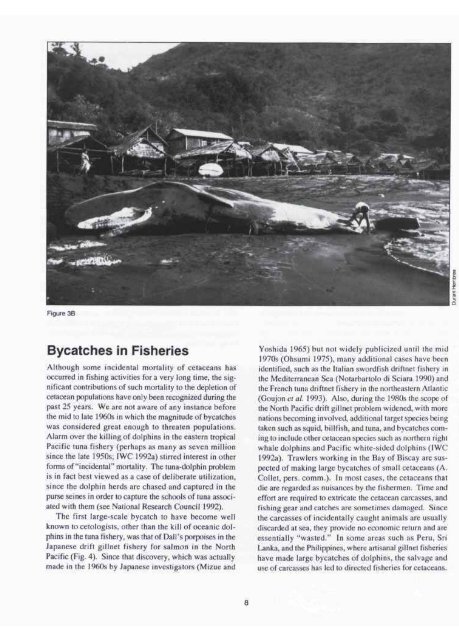Dolphins, Porpoises, and Whales - IUCN
Dolphins, Porpoises, and Whales - IUCN
Dolphins, Porpoises, and Whales - IUCN
You also want an ePaper? Increase the reach of your titles
YUMPU automatically turns print PDFs into web optimized ePapers that Google loves.
Figure 3B<br />
Bycatches in Fisheries<br />
Although some incidental mortality of cetaceans has<br />
occurred in fishing activities for a very long time, the significant<br />
contributions of such mortality to the depletion of<br />
cetacean populations have only been recognized during the<br />
past 25 years. We are not aware of any instance before<br />
the mid to late 1960s in which the magnitude of bycatches<br />
was considered great enough to threaten populations.<br />
Alarm over the killing of dolphins in the eastern tropical<br />
Pacific tuna fishery (perhaps as many as seven million<br />
since the late 1950s; IWC 1992a) stirred interest in other<br />
forms of "incidental" mortality. The tuna-dolphin problem<br />
is in fact best viewed as a case of deliberate utilization,<br />
since the dolphin herds are chased <strong>and</strong> captured in the<br />
purse seines in order to capture the schools of tuna associated<br />
with them (see National Research Council 1992).<br />
The first large-scale bycatch to have become well<br />
known to cetologists, other than the kill of oceanic dolphins<br />
in the tuna fishery, was that of Dall's porpoises in the<br />
Japanese drift gillnet fishery for salmon in the North<br />
Pacific (Fig. 4). Since that discovery, which was actually<br />
made in the 1960s by Japanese investigators (Mizue <strong>and</strong><br />
Yoshida 1965) but not widely publicized until the mid<br />
1970s (Ohsumi 1975), many additional cases have been<br />
identified, such as the Italian swordfish driftnet fishery in<br />
the Mediterranean Sea (Notarbartolo di Sciara 1990) <strong>and</strong><br />
the French tuna driftnet fishery in the northeastern Atlantic<br />
(Goujon et al. 1993). Also, during the 1980s the scope of<br />
the North Pacific drift gillnet problem widened, with more<br />
nations becoming involved, additional target species being<br />
taken such as squid, billfish, <strong>and</strong> tuna, <strong>and</strong> bycatches coming<br />
to include other cetacean species such as northern right<br />
whale dolphins <strong>and</strong> Pacific white-sided dolphins (IWC<br />
1992a). Trawlers working in the Bay of Biscay are suspected<br />
of making large bycatches of small cetaceans (A.<br />
Collet, pers. comm.). In most cases, the cetaceans that<br />
die are regarded as nuisances by the fishermen. Time <strong>and</strong><br />
effort are required to extricate the cetacean carcasses, <strong>and</strong><br />
fishing gear <strong>and</strong> catches are sometimes damaged. Since<br />
the carcasses of incidentally caught animals are usually<br />
discarded at sea, they provide no economic return <strong>and</strong> are<br />
essentially "wasted." In some areas such as Peru, Sri<br />
Lanka, <strong>and</strong> the Philippines, where artisanal gillnet fisheries<br />
have made large bycatches of dolphins, the salvage <strong>and</strong><br />
use of carcasses has led to directed fisheries for cetaceans.

















